75 years after “the worst avoidable disaster in the Capital City’s history,” outdoor commercial venues are safer than ever before
By all accounts, danger lurked far from the minds of the estimated 7,000 spectators crowded beneath the big top of the Ringling Bros. and Barnum & Bailey Circus on a sweltering summer day in 1944. But less than an hour after the show began, the Hartford Circus Fire claimed the lives of 167 people and injured 682 more.
In this fifth installment of our series on lessons learned from the deadliest fires in U.S. history, we examine the poor decisions and lax rules that led to what the Hartford Courant deemed “the worst avoidable disaster in the Capital City’s history.” And we explain how the heart-wrenching lessons learned from the tragedy have made public events involving tents, grandstands, and bleachers safer today—and led to the creation of a new National Fire Protection Association (NFPA) standard.
Looking for fire protection system parts? Feel free to browse our selection of sprinkler system components and accessories, including commercial and residential sprinkler heads, installation tools, fire extinguishers, and so much more.
Hartford was a city in need of a break when the circus rolled into town
The “Greatest Show on Earth” was already off to a shaky start in Hartford, CT. With so many Americans fighting in World War II or needed in factories to support the war effort, the circus was severely short-staffed, missing 300 of the 1,600 workers it depended on to operate. It had rolled into town so late from its previous run in Providence, RI, that it had to cancel its first Connecticut show, a sure sign of bad luck to superstitious circus folk.
Hartford was a town in desperate need of a break, with residents pulling double shifts at area factories like Colt Firearms and Sikorsky to keep up with war-production demands. In the pre-television era, a visit from the circus was a much-heralded event.
July 6, 1944 dawned as a typical Northeastern mid-summer day, with temperatures approaching 90 degrees by the afternoon and the air thick with stifling humidity. Exactly a month after D-Day, people were filled with hope that the war would soon end. With many local men still overseas, it was mostly women and children who turned out in droves for the ill-fated matinee, nearly filling the big top to capacity.
Ringling Bros.’ massive tent was pitched on a city-owned circus lot and a 1944 NFPA report states “there was some haste” in getting it ready for the 2 p.m. show since it had arrived so late. At 74,000 square feet, the tent covered more than 1.5 acres and weighed about 19 tons. It could seat 9,000: 6,000 in reserved seating and another 3,000 in general admission.
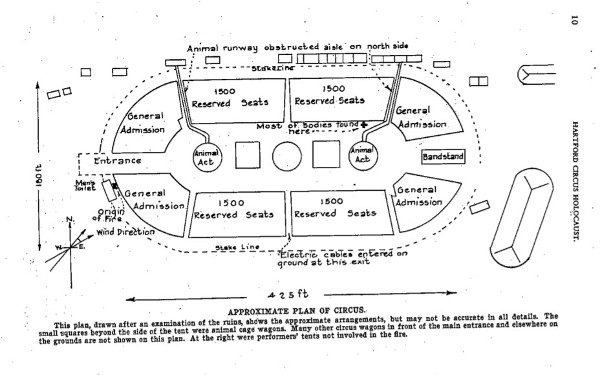
In the 1940s, city codes did address the number and size of exits, the placement of fire extinguishers, flameproofing, and other safety issues. But the rules were mostly focused on fixed structures like theaters and far less strict for temporary entertainment venues like circus tents. Even after Ringling Bros. suffered a serious fire that killed 50 animals in Cleveland two years before, fire safety at the circus remained a matter of custom and expediency.
An inspector from Hartford’s building department issued a permit before the circus’s stands were even up, with no indication that critical issues like exit widths or flameproofing of the tent were considered. The local fire prevention bureau received no official notice that the permit had been issued or even that the circus was in operation. After all, Ringling Bros. had visited Hartford before and traveled throughout New England in previous weeks, and the setup was always the same. The circus was an institution older than many cities’ building codes, and the NFPA report asserts that local officials welcomed it without question.
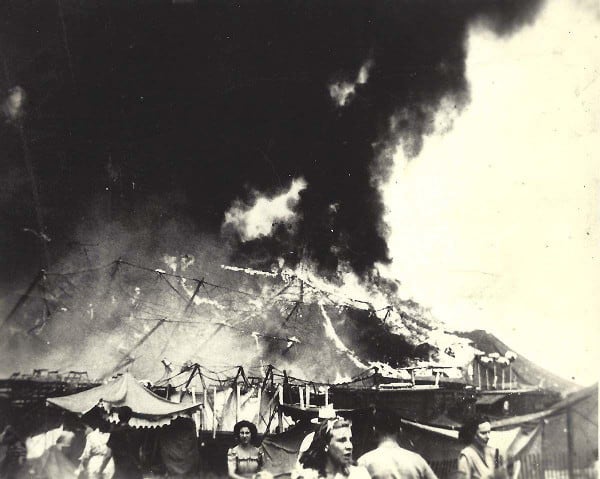
What went wrong on “the day the clowns cried”
The wild-animal act had just ended, and the crowd was watching with hushed anticipation as the famous Flying Wallendas started their high-wire aerial act when the band suddenly broke into “The Stars and Stripes Forever.” The song is a universal emergency signal for circus employees. The band leader had spotted flames on the windward side of the tent, about 20 feet south of the main entrance.
Witnesses later said the flames were about five or six feet high when the band started playing—still small enough to have been potentially controlled by a fire extinguisher, according to the NFPA report. But although the circus had dozens of fire extinguishers, none had been removed from storage and distributed throughout the tent. Even worse, many were empty or had not been inspected or re-charged in some time.
Officially unaware of the circus performance, the Hartford fire department did not have a detail on site until it was called to extinguish the flames. The circus usually stationed four of its own water trucks outside the tent during performances, but they had been used to carry water for the animals and sprinkle the dry, dusty grounds, and were more than a quarter-mile away when the fire sparked. Even if they had been nearby, few of their hoses fit the city’s fire hydrants. The only fire extinguishing equipment immediately on hand were buckets of water, which proved ineffective against the raging blaze.
The ringmaster tried to keep the audience calm but his instructions faded as the power to his microphone failed. People stampeded toward the tent’s nine exits—only to discover that some of them were blocked.
Circus employees had erected chutes of portable metal fencing to guide the big cats between their cages in the ring and trucks parked outside the tent. The chutes were still in place at two exits when the fire broke out, blocking frantic audience members from escaping. Some people who tried to climb over the chutes were clawed by the panicked cats. After the fire, bodies were piled so high at the cat chutes that firefighters found buried children still alive, shielded by the people on top of them.
The cause of the fire was never officially determined. A widely accepted theory involved a carelessly flicked cigarette in a tent that lacked “No Smoking” signs. Robert Dale Segee, then a 14-year-old circus hand who was later convicted of other arsons, confessed to starting the fire in 1950 but then recanted.
No matter how it started, the fire spread at astonishing speed, racing across a circus tent that had been waterproofed with a mixture of 1,800 pounds of paraffin wax and 6,000 gallons of gasoline, the Hartford Courant reported—essentially transforming it into a giant wick. Patches of burning canvas rained down on the terrified audience, igniting hair and clothing.
In the mad rush to escape, some people fell and were either crushed or suffocated beneath piles of bodies. Others died after leaping 12 feet off the bleachers to avoid the flames. And still others were trapped as patrons scrambling down the stands and tossed unattached folding chairs out of their way, creating a tangled barrier for those behind them.

Tales of heroism abounded. A man flung children over the tops of the animal chutes at the blocked exits. Other spectators and circus employees used pocketknives to slit through the tent and pull people to safety; The New York Times reported that a 13-year-old boy later received an award from Connecticut’s governor and a scholarship to the University of Connecticut for helping 600 people escape. Circus clown Emmett Kelly was famously photographed carrying a bucket of water during the fire—appearing in newspaper reports nationwide under the headline, “The Day the Clowns Cried.”
But within less than 10 minutes, the tent’s ropes were consumed by flames and its foot-thick poles gave way, crushing people as they fell and bringing the 19-ton, burning big top crashing down on anyone still trapped inside. By the time the Hartford fire department arrived, the tent had completely collapsed, and the fire was consuming the wooden stands. All that was left to do was douse the flames and begin recovering bodies and searching for survivors.
Unlike most fires, where smoke inhalation is the leading cause of death, the NFPA report stated that many circus fire victims died of severe burns, charred so badly that they had to be identified by scraps of clothing, jewelry, or dental records. Nearly 70 of the people who perished were younger than 15 years old. The identity of some victims was never discovered.
Six Ringling Bros. officials were charged with involuntary manslaughter after the fire and five served prison time, The New York Times reported. Ultimately, the circus would pay just under $4 million in reparations to victims and their families.
Watch this video to learn more about the tragic Hartford circus fire. Warning: some images may be disturbing:
How the Hartford Circus fire made temporary entertainment venues safer today
Edward J. Hickey, Connecticut’s state police commissioner and state fire marshal, was at the doomed matinee with his nieces and nephews. He and his family emerged unscathed, and he was onsite to coordinate initial rescue efforts and the early stages of the investigation.
Ironically, Hartford had won the grand award in the Inter-Chamber Fire Waste Contest a few weeks before the circus disaster for implementing aggressive fire safety measures like adequate exits from places of public assembly. But Hickey witnessed the horror of people burning as they desperately tried to escape through bottlenecked exits in the tent that were too narrow and few—and immediately understood that fire safety codes and enforcement governing temporary structures were woefully inadequate.
NFPA code of the time, for instance, required 22-inch units of exit width for every 100 people. The circus tent had only 43 of the 91 units required, according to the NFPA report. And two of the exits were blocked. NFPA code also required venues with more than 200 seats to securely fasten seating to the floor. But a substantial portion of the circus’s reserved seating section was comprised of loose folding chairs that became a tangled obstacle as they were shoved about by people trying to escape.
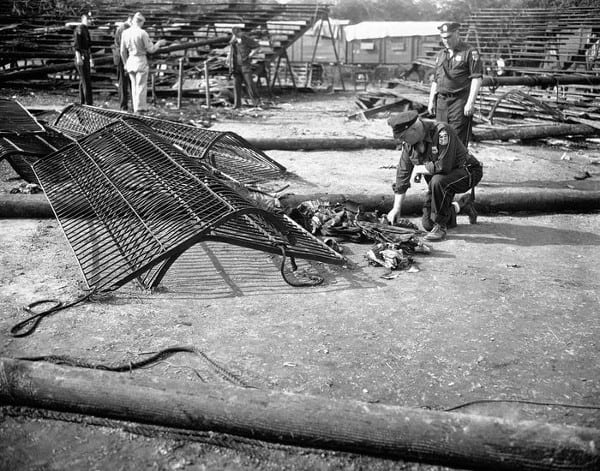
In the wake of the tragedy, the city of Hartford and the state of Connecticut launched investigations into the circus and the performance of city officials and departments. Reports turned up glaring deficiencies that investigators asserted would never have been allowed to slide in a fixed structure, such as the flammability of the tent, the lack of necessary firefighting equipment, and the inadequate means of egress. Investigators also noted the failure of city departments to coordinate with each other.
Horrified by these breaches, city and state officials took full advantage of Hartford’s position as the nation’s insurance capital. They recruited insurance executives to help draft the toughest fire regulations for temporary shows in the nation. The fire also prompted other cities, counties, and states to conduct an intense review of their own regulations governing circuses and other forms of traveling entertainment—and Hartford’s regulations quickly spread nationwide.
Chief among the new demands were requirements for:
- Circuses and commercial tents to have fire departments on standby for all performances, with hose lines charged.
- A dedicated fire watch patrolling the premises throughout events to catch early signs of danger
- Aisles that are clear of seating.
- Numerous, unobstructed exits from all parts of an enclosure—even if seating must be reduced to accomplish it. No temporary uses are permitted to block the minimum number of required exits; instead, additional exits must be added for animals, performers, and other uses.
- Flame-retardant treatments for tents.
- An adequate supply of fire extinguishing equipment on hand, with employees trained in its use.
- Smoking restrictions.
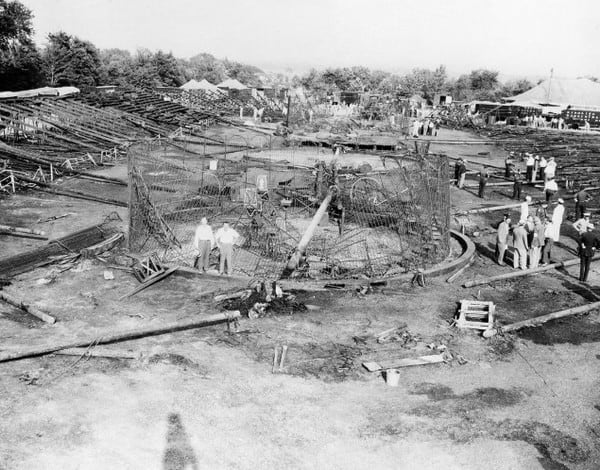
The fire also spurred demands for increased staffing at fire-prevention bureaus, which the NFPA report said had been decimated so badly by the war that they shut down in some jurisdictions. And within months, a joint committee had been established by the Building Officials Conference of America and NFPA, following the procedure of the American Standards Association (ASA). The ASA—now operating as the American National Standards Institute (ANSI)—coordinates the development of voluntary consensus standards in the U.S.
The joint committee acted quickly, preparing a draft of a new proposed standard governing carnivals, fairs, circuses, exhibitions, contests, auctions, and other outdoor amusement assemblies that was submitted to NFPA’s annual meeting in June 1945. Hartford’s building inspector and several Hartford insurance executives provided input.
The new standard was approved less than a year later and adopted by jurisdictions nationwide, setting the first national standard for fire safety in the outdoor amusement industry. It established strict oversight of temporary, traveling entertainment venues by detailing requirements for exit and aisle passages, flameproofing tents, fastening of seats, training of personnel, a minimum number of exits, the amount and location of firefighting equipment, the use of ventilators to draw off heat and gases in the event of a fire, emergency lighting systems to prevent panic during power outages, and more.
In 1950, a separate standard on grandstands was folded into the new code, addressing new types of grandstands as well as foldable versions in buildings that had not been previously covered. Today, NFPA 102: Standard for Grandstands, Folding and Telescopic Seating, Tents, and Membrane Structures compiles relevant extracts from NFPA 101: Life Safety Code and NFPA 5000: Building Construction and Safety Code into a convenient resource.
NFPA 102 covers construction, location, means of egress, maintenance, and protections like alarm systems and rules for heaters and pyrotechnics. Its goal: to ensure every effort is made to protect people from fire, storm, collapse, and the dangers of panic and crowd behavior at outdoor amusement venues.
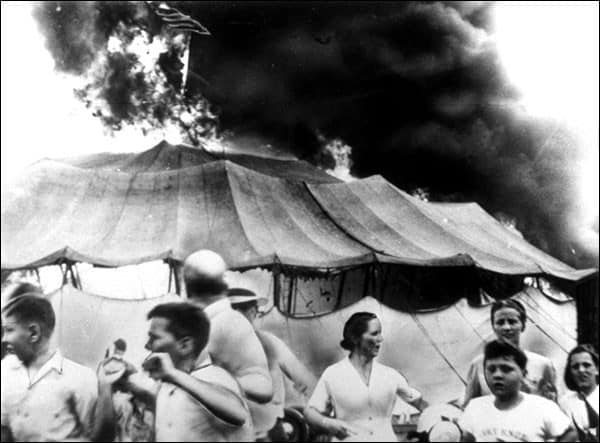
In the 75 years since the Hartford circus fire, no Americans have perished in a tent fire
On July 16, 1956—12 years and 10 days after the tragic Hartford fire—the Ringling Bros. circus performed its last tent show under a canvas big top in Pittsburgh, Penn. Labor costs and unionization battles had made it too costly to preserve the traveling big top and the circus performed at indoor arenas thereafter.
In May 2017, the 146-year-old circus took its final curtain call. It seems fitting that it visited Hartford at the end of its final tour, staging an uneventful performance on April 30, 2017.
The traditional type of circuses like Ringling Bros. that drew thousands in 1944 is becoming harder to find. Circuses that remain in the U.S. have largely morphed into something new, like the highly successful Cirque du Soleil that combines music, acrobatics, and storytelling at big tops, arenas, and theaters worldwide.
But the legacy of the old-fashioned circus lives on in the tougher rules and stricter oversight of temporary entertainment venues inspired by the Hartford fire. Since that ill-fated matinee, the Hartford Courant proudly reports that not a single American life has been lost in a commercial tent fire.
Be sure to check out other installments in our series on lessons learned from the deadliest fires in U.S. history:
The Iroquois Theater Fire and the Triangle Shirtwaist Fire
The Our Lady of the Angels School Fire and The Station Nightclub Fire
The MGM Grand Fire in Las Vegas
The Beverly Hills Supper Club Fire
If you need fire protection equipment, see our selection of sprinkler system components and accessories, including commercial and residential sprinkler heads, installation tools, fire extinguishers, and so much more.
For more information about QRFS products, call us at +1 (888) 361-6662 or email support@qrfs.com.
This blog was originally posted at blog.qrfs.com. Check us out at Facebook.com/QuickResponseFireSupply or on Twitter @QuickResponseFS.


